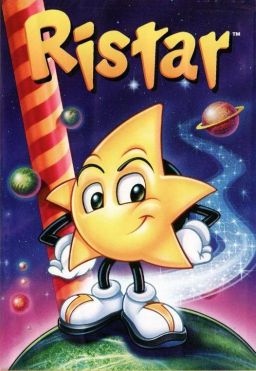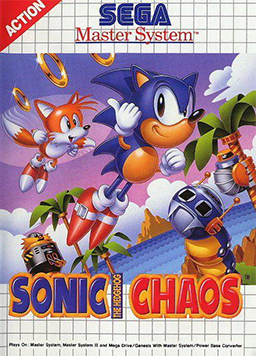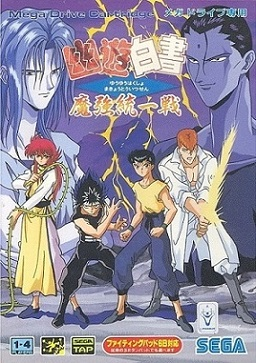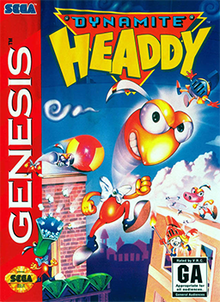
Radiant Silvergun is a shoot 'em up video game developed and published by Treasure. It was originally released in Japanese arcades in 1998 and subsequently ported to the Sega Saturn later that year. The story follows a team of fighter pilots in the far future who are battling waves of enemies summoned by a mysterious crystal dug up from the Earth. The player hosts an arsenal of six different types of shots to choose from, and a sword to destroy nearby targets. The stages are tightly designed to present players with scenarios that can be approached differently with the various weapon types.

Treasure Co., Ltd. is a Japanese video game developer based in Tokyo known for its action, platform, and shoot 'em up games. The company was founded in 1992 by former Konami employees seeking to explore original game concepts and free themselves from Konami's reliance on sequels. Their first game, Gunstar Heroes (1993) on the Sega Genesis, was a critical success and established a creative and action-oriented design style that would continue to characterize their output. Treasure's philosophy in game development has always been to make games they enjoy, not necessarily those that have the greatest commercial viability.

Ristar is a 1995 platform game developed and published by Sega for the Sega Genesis. The game stars an anthropomorphic cartoon star who uses his hands and long, stretchable arms to both move and fight enemies. Reception for the game was generally positive, but the game's initial release was overshadowed due to the imminent ending of the Genesis's lifecycle and the succession of the Sega Saturn and other fifth generation video game consoles.

Mischief Makers is a side-scrolling platform game developed for the Nintendo 64 gaming console by Treasure, and published in 1997 by Enix in Japan and by Nintendo internationally. The player assumes the role of Marina Liteyears, a robotic maid who journeys to rescue her creator, Professor Theo, from the emperor of Planet Clancer. The gameplay is displayed in 2.5D, based on grabbing, shaking, and throwing objects within five worlds and 52 levels.

Gunstar Heroes is a run and gun video game developed by Treasure and published by Sega. It was Treasure's debut game, originally released for the Sega Genesis in 1993. The game's premise is centered around a pair of characters, the Gunstars, in their efforts to stop an evil empire from recovering four powerful gems. The characters can fire guns and perform a series of acrobatic maneuvers to fight enemies across each stage. There are four weapons in the game which can be combined with one another to create different shot types.

Sonic Chaos is a 1993 platform game published by Sega for the Master System and Game Gear. Players control Sonic the Hedgehog and his sidekick Miles "Tails" Prower in their quest to retrieve the Chaos Emeralds from Doctor Robotnik, who has stolen them to construct nuclear weapons. Gameplay involves running through stages, collecting rings, and defeating enemies. It is largely based on the Master System version of Sonic the Hedgehog 2, and is thus considered a follow-up to that game. Chaos is the first Sonic game for the Master System and Game Gear to feature Tails as a separate playable character with his own unique abilities.

Gunstar Super Heroes is a run and gun video game for the Game Boy Advance developed by Treasure and published by Sega in 2005. It is the sequel to the 1993 Sega Genesis game Gunstar Heroes, with the story taking place after the events of the original game and featuring an expanded combat system over its predecessor.

Sonic the Hedgehog 2 is a 1992 platform game developed by Aspect and published by Sega for the Master System and Game Gear. It is the sequel to the 8-bit Sonic the Hedgehog (1991) and follows Sonic as he attempts to get the Chaos Emeralds back to rescue his friend Miles "Tails" Prower from Dr. Robotnik. Like the first Sonic the Hedgehog, players run through levels at high speeds while collecting rings and defeating enemies. Although it shares the same title with Sonic the Hedgehog 2 for the Sega Genesis and their releases coincided, the games have little in common and share no levels.

Alien Soldier is a side-scrolling run and gun video game developed by Treasure and published by Sega for the Mega Drive. Retail copies were released in Japan and PAL territories while in North America it was only available exclusively via the Sega Channel cable service. The story follows a powerful being named Epsilon-Eagle, who after being nearly killed becomes determined to avenge his near death and save his planet. The character has a variety of weapons and moves that the player must master to complete the game. Many gameplay ideas are borrowed from Treasure's earlier Mega Drive release, Gunstar Heroes (1993). However, Alien Soldier puts an emphasis on challenging boss fights with short and easy levels serving as downtime in-between.

Wonder Boy in Monster World, known in Japan as Wonder Boy V: Monster World III, is a side-scrolling action role-playing game originally developed by Westone and published by Sega for the Mega Drive/Genesis in 1991. It is the fifth game in the Wonder Boy series and the third game in the Monster World sub-series, following Wonder Boy in Monster Land and Wonder Boy III: The Dragon's Trap.

Light Crusader is an action-adventure game developed by Treasure and published by Sega for their Sega Genesis console in 1995. The game was included in the Sega Genesis Classics collections on Steam and other platforms in 2011. It was also included on the Sega Genesis Mini in North America and Sega Mega Drive Mini in PAL regions.

Karnov's Revenge is a 1994 fighting game developed by Data East, released for the Neo Geo. It is the second game in the Fighter's History series. The game was later ported to the Neo Geo, Neo Geo CD and Sega Saturn home consoles.

McDonald's Treasure Land Adventure is a 1993 platform game developed by Treasure and published by Sega for the Sega Genesis. Based on the McDonald's fast food restaurant chain, specifically its McDonaldland marketing campaign, players control Ronald McDonald in his efforts to retrieve the missing pieces of a map that lead to the location of a buried treasure from a group of villains. Ronald can defeat enemies by using a magic attack and can latch onto hooks with his scarf to reach higher platforms.

Naruto: Ultimate Ninja, known in Japan as the Naruto: Narutimate Series, is a series of fighting video games, based on the popular manga and anime series Naruto by Masashi Kishimoto. It was developed by CyberConnect2, and published by Bandai and later Bandai Namco Games. The first game was released in 2004 for the PlayStation 2, and was followed by four more titles for the system, as well as five spinoffs for the PlayStation Portable. A follow-up for the PlayStation 3, titled Naruto: Ultimate Ninja Storm, was the first to feature three-dimensional battles, and began the long-running Storm sub-series. While starting out as a series exclusive to the PlayStation family of systems, the series has also been present on Xbox and PC platforms since the release of Naruto Shippuden: Ultimate Ninja Storm 2 for the Xbox 360 and Naruto Shippuden: Ultimate Ninja Storm 3 Full Burst for Windows, respectively. Latest releases were also ported to the Nintendo Switch. The Naruto: Ultimate Ninja series sold over 20 million copies worldwide as of December 2019.

Vectorman is a 2D action platformer video game developed by BlueSky Software and published by Sega. The game was released for the Sega Genesis in late 1995 in North America and Europe. It was considered a critical and commercial success, achieving its dual goal of retaining interest in the aging Sega Genesis platform in face of the increasingly popular new technology of the next generation of video game consoles and providing competition to industry competitor Nintendo's popular Donkey Kong Country video game. In subsequent decades, the game was re-released across many Sega-themed video game compilations, and on its own across the Wii Virtual Console, Steam, and the Sega Forever line of mobile game releases. A sequel, Vectorman 2, was released in 1996, but despite several abandoned attempts at making an Vectorman 3, no further games have been released.

M2 Co., Ltd. is a Japanese video game developer and publisher, best known for handling emulation of re-released games, such as some Sega Ages titles, Virtual Console titles for Nintendo systems, the 3D Classics series for the Nintendo 3DS and their ShotTriggers range of classic STG games. M2 has also created entirely new titles such as WiiWare games for Konami under the ReBirth moniker and more recently a new GG Aleste game. In addition, M2 currently holds the rights of Aleste series and all NEC Avenue and NEC Interchannel games on TurboGrafx-16 and variants, previously owned by Lightweight.

Ristar is a platform video game released by Sega in February 1995 for the Game Gear. While sharing themes and gameplay elements from its main counterpart, Ristar, for the Sega Genesis, it is a largely different game. The game was well received by critics, who felt the gameplay mechanics were transferred over well to the older, aging Game Gear system, but were divided on whether or not the game was worth playing if both versions of the game were available to the consumer. The game received even less exposure than its Genesis counterpart, due to the Game Gear being towards the end of its lifecycle, and having less of a userbase to begin with in comparison to the Genesis.

Sega Forever is a service from the Japanese video game developer Sega for re-releasing past games from the company on modern platforms. The service was launched for Android and iOS devices on June 22, 2017. By 2020, the service included over 30 games.

Yu Yu Hakusho Makyō Tōitsusen is a 1994 fighting game developed by Treasure and published by Sega for the Mega Drive. It is based on the manga series Yu Yu Hakusho by Yoshihiro Togashi. The plot follows the protagonist Yusuke Urameshi, who is tasked by the ruler of the afterlife with solving detective-style cases involving both humans and demons threatening the living world. The story begins to focus heavily on martial arts battles as it progresses.



















